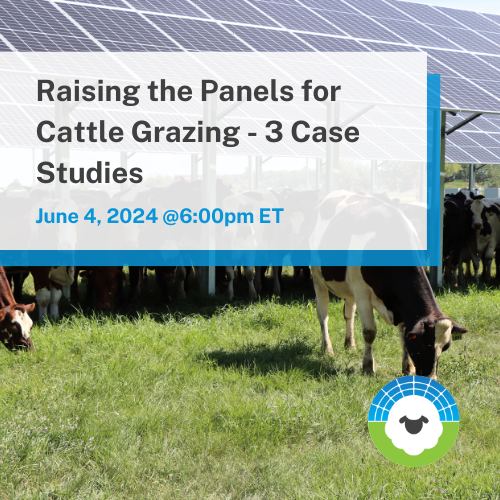Raising the Panels for Cattle Grazing (ASGA Call 78)

How do you make solar arrays cattle proof and what does cattle grazing under solar panels look like now?
To provide an update on some of the latest developments in solar cattle, we invited 3 sets of speakers to discuss how they’re integrating cattle grazing operations on community scale arrays on farms in Minnesota, Massachusetts, and Pennsylvania.
At the webinar, they discussed site modifications to accommodate cattle, and how farmers are integrating the arrays into their farms and managing their grazing operations.
Our ASGA event recordings are available to members of ASGA’s online network. Not a member? Please join us here!
About the Speakers
Here is the lineup of speakers and their respective cattle grazing projects:
Anna Clare Monlezun kicked us off by discussing the state of solar cattle, both the practice and the science. She went into the growing pains of bringing two very different industries (energy + cattle) together in collaboration and the importance of understanding how cattle grazing needs to be context specific. Anna Clareis the Agrivoltaics Research Lead for a U.S. Department of Energy funded project in partnership with utility solar developer Silicon Ranch. With a background in rangeland ecology and ranching, she brings to the field of agrivoltaics and the solar industry a “systems” perspective, where ecosystem stewardship is equally paramount to the production of clean energy. Her work in agrivoltaics has recently expanded to also include consulting, project development, advocacy, and education.
Tom Roberts and his daughter Michelle run Burgundy Brook Farm in Belchertown, MA. On their 700 acre farm, they’ve installed a 16 acre array where they’ll be growing hay and doing rotational cattle grazing under the panels. They talked about how they plan to manage the grazing and hay operation at the new array. Jesse Robertson-Dubois from BlueWave Energy also discussed the system design, which uses single-axis trackers and 10-feet vertical clearance.
Doug Neidich from solar developer GreenWorks Development (www.greenworksdev.com) in Harrisburg, PA, talked about his work on several 10-acre solar arrays on farms in Pennsylvania for cattle grazing. They use a 7-foot minimum height array for cattle, but also do arrays at a 3-foot minimum height for sheep grazing and a 9-foot height for horses.
Brad Heins from the University of Minnesota’s West Central Research and Outreach Center, gave us an update on the center’s ongoing agrivoltaics project on their dairy farm. They’ve been running the program since 2017 and are grazing up to 250 heads of cattle. Brad discussed the system design, the research results they’ve observed, and their efforts to develop a 20kw portable solar system for pasture grazing.
Thanks to our sponsor!!

